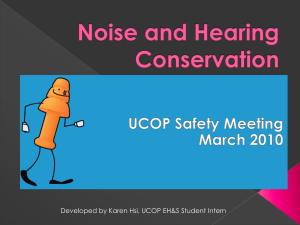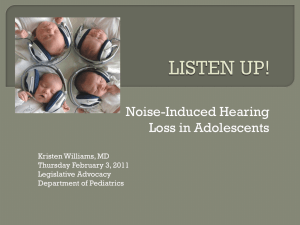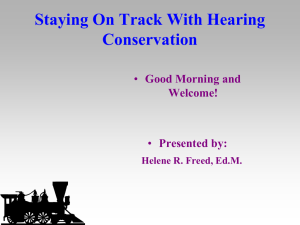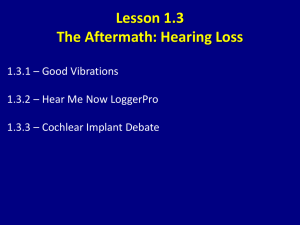Introduction to Hearing Aids - Hearing Loss Association of North
advertisement
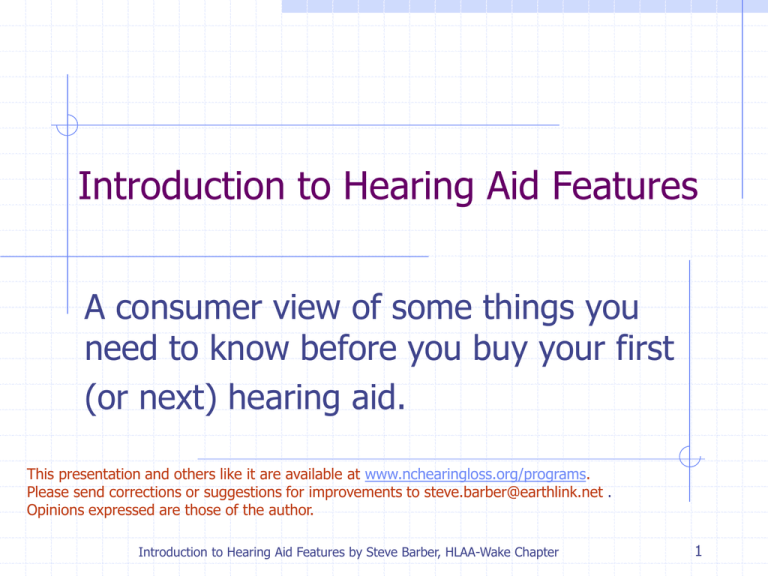
Introduction to Hearing Aid Features A consumer view of some things you need to know before you buy your first (or next) hearing aid. This presentation and others like it are available at www.nchearingloss.org/programs. Please send corrections or suggestions for improvements to steve.barber@earthlink.net . Opinions expressed are those of the author. Introduction to Hearing Aid Features by Steve Barber, HLAA-Wake Chapter 1 Why Should I Care? Hearing aids are Expensive. Hearing aids aren’t like glasses. You need to be an informed consumer. You need to know how to use the aid. There are a lot of misconceptions about hearing aids. Hearing better is UP TO YOU! Introduction to Hearing Aid Features by Steve Barber, HLAA-Wake Chapter 2 What Should I Care About? Highest Priority: Hearing Better High Priority: Learning to Use Your Aid Lowest Priority: Vanity Introduction to Hearing Aid Features by Steve Barber, HLAA-Wake Chapter 3 All Hearing Aids Are Alike 1. Sound goes in the Microphone. 2. Sound gets amplified. 3. Sound comes out the Speaker into your Ear Introduction to Hearing Aid Features by Steve Barber, HLAA-Wake Chapter 4 All Hearing Aids Are Different Style (Small is best? … not always) Technology (Digital is the way to go? … probably) Features (More is better? … sometimes) Settings (your ‘prescription’ … a starting point) Introduction to Hearing Aid Features by Steve Barber, HLAA-Wake Chapter 5 Style Body Behind The Ear (BTE) Mini BTE In The Ear (ITE) In The Canal (ITC) Completely In the Canal (CIC) Introduction to Hearing Aid Features by Steve Barber, HLAA-Wake Chapter 6 Technology Analog: Settings and Sound are both processed via analog technology. Digital Programmable: Settings are processed digitally, Sound is processed via analog technology. Full Digital: Both Settings and Sound are processed digitally. Opinion: Full Digital is now probably best in most cases, but not the miracle that some imply. For some people analog or digital programmables are fine, but most hearing aids in the future will be full digital. Introduction to Hearing Aid Features by Steve Barber, HLAA-Wake Chapter 7 Features Volume Control Telecoil Multiple Microphone Directionality Compression Clipping Direct Audio Input FM Bluetooth Programmability Speech Enhancement/Noise Reduction Frequency Shifting Earmold/Vent Remote Control Introduction to Hearing Aid Features by Steve Barber, HLAA-Wake Chapter Opinion: Learn what these features can do to help you hear better so that you will be a better consumer. 8 Volume Control Some aids are preset and you can’t control the volume. Some manufacturers and dispensers think you don’t need it. Not having a volume control is Ok for a few people who really don’t need it or can’t manage it. Very useful to be able to control the volume to match the situation. Control may be a wheel, button or lever on the aid, or a remote control. Opinion: Usually very important. Introduction to Hearing Aid Features by Steve Barber, HLAA-Wake Chapter 9 Telecoil Sound Input Signal Magnetic Input Signal Alternate input source Listens to magnetic signal instead of (or in addition to) the sound. Magnetic signal can be from a telephone, CD, TV, personal ALD, headphone, loop Major advantage is improved signal to noise Usually on BTEs; sometimes on smaller, seldom on smallest You may have to ASK (or DEMAND) if you want telecoils! Opinion: Very Valuable Introduction to Hearing Aid Features by Steve Barber, HLAA-Wake Chapter 10 Multiple Microphone Directionality Front Facing Directional Mic Rear Omnidirectional Mic Aid Can Focus on Sounds in Front and Diminish Background Noise Selectable Modes Quiet situations: hear everything Noisy situations: block background noise Manual or Auto Selection Opinion: Very Valuable Introduction to Hearing Aid Features by Steve Barber, HLAA-Wake Chapter 11 Compression Amplification 100 80 60 40 20 0 quiet loud Amount of Noise Reduces Amplificaton when it’s Noisy Helps you hear more when it’s Quieter Keeps it from being Painful when it’s Noisy Adjustable (manual and automatic) Different settings in multiple frequency bands Opinion: Very useful; available on most aids; may requre tweaking to set right. Introduction to Hearing Aid Features by Steve Barber, HLAA-Wake Chapter 12 Amplification Clipping 100 90 80 70 60 50 40 30 20 10 0 Normal Amplification quiet No Amplification loud Amount of Noise Eliminates all amplificaton above a certain input volume Prevents hearing damage from excessive amplification in loud situations A setting for most hearing aids Opinion: Essential for safety; available on most aids Introduction to Hearing Aid Features by Steve Barber, HLAA-Wake Chapter 13 Direct Audio Input (DAI) Alternate input source Listens to electrical signal instead of (or in addition to) the sound. Electrical signal can be from a telephone, CD, TV, or personal ALD Major advantage is improved signal to noise Boots available only for BTEs Opinion: Very good signal; comparable to FM, but requires the wires. Introduction to Hearing Aid Features by Steve Barber, HLAA-Wake Chapter 14 Booted or Integrated FM Some Aids have FM receivers either booted on (as shown) or integrated into the aid. Some can be used with handheld transmitters or with fixed transmitters which can integrate TV and Telephone. Clean signal; bridges distance; improves signal to noise ratio. Opinion: Expensive but wonderful if you can afford it. Introduction to Hearing Aid Features by Steve Barber, SHHH Wake Chapter 15 Bluetooth Some Aids have an optional Bluetooth pendant that use a proprietary magnetic interface. Any aids with a telecoils can use a Bluetooth pendant that uses an analog neckloop. Some aids have both (Ask if you want both!) Bluetooth has some advantages. Personal connectivity to TV, Phone, iPods, Tablets Clean signal; bridges distance; improves signal to noise ratio. Proprietary versions have advantages True 2-channel stereo No EMI (interference) Bluetooth has some disadvantages: Opinion: Not terribly expensive, and nice to have if you want that connectivity. A bit “techie” for some Requires a pendant/neckloop Some delay in audio Personal: Doesn’t do “broadcast” Introduction to Hearing Aid Features by Steve Barber, HLAA-Wake Chapter 16 Programmability The ability of an aid to have several different sets of settings Hearing aid dealer/audiologist chooses and sets up the programs User can switch among the programs Examples of useful programs for quiet situations for noisy situations for music telecoil or DAI with or without microphones FM May be controlled with a switch or button on the aid or with a remote control Opinion: Very valuable, but you must understand, choose and learn how to use the options. Introduction to Hearing Aid Features by Steve Barber, HLAA-Wake Chapter 17 Speech Enhancement and Noise Reduction Speech Enhancement Enhance certain speech sounds (like consonants) Noise Reduction Processing Identify speech in the signal and separate it from noise Opinion: May be useful in some situations but these are not miracles and their benefit may not be obvious in many situations. Introduction to Hearing Aid Features by Steve Barber, HLAA-Wake Chapter 18 Frequency Shifting dB 2k 0 10 20 30 40 50 60 70 80 90 100 4k Can Hear 6k 8k Can’t Hear Only one aid, so far (AVR ImpaCT) Lowers the frequency of sounds you can’t hear into a range where you can hear them. Does some speech enhancement, too With practice those new sounds start to sound realistic. Opinion: Most likely useful for steep ski slopes Introduction to Hearing Aid Features by Steve Barber, HLAA-Wake Chapter 19 Ear Mold Design Adaptor Bore The shape and smoothness of the bore The size and smoothness of the vent Depth Vent Too small: Drum Feeling Too Large: Feedback Depth of the mold Smoothness of the adaptor Opinion: Very important, and much ovelooked. Introduction to Hearing Aid Features by Steve Barber, HLAA-Wake Chapter 20 Open Fitting People with mild or moderate hearing losses can consider an “open fitting” instead of an full ear mold. An open fitting is common on mini-BTE aids like the one shown. Not suitable for more serious losses. Introduction to Hearing Aid Features by Steve Barber, HLAA-Wake Chapter 21 Remote Controls Let you control your aids conveniently Some simple; some powerful Some people like them; some don’t Control: Volume Program Mode Opinion: Very convenient; especially if it allows direct access to individual programs. Introduction to Hearing Aid Features by Steve Barber, HLAA-Wake Chapter 22 Feature Availability By Type Feature / Type BTE ITE ITC CIC Telecoil Most Some ??? ??? Directional Mics Some Rare No No Compression/Clipping Yes Yes Yes Yes DAI Some No No No FM Some Few ??? No Bluetooth Some ??? ??? ??? Programmability Most Most Some Some Power Plenty Less Less Less Remote some some few ??? Introduction to Hearing Aid Features by Steve Barber, HLAA-Wake Chapter 23 Summary Put hearing better as the top priority. Put vanity at the bottom of your priorities. Be a savvy consumer; know what features might help you. Watch out for people trying to sell you what they THINK you want. Choose a provider that lets you try multiple aids/settings. Small is not necessarily better (and usually isn’t). Introduction to Hearing Aid Features by Steve Barber, HLAA-Wake Chapter 24 Summary (cont.) Watch out for sales pitches; if it sounds too good to be true; it probably is. Get professional help from someone you trust. New is not necessarily better (but sometimes is). Use the trial period. Try the aids in different situations and make notes. Work with your provider during the trial period by explaining what things sound good or bad to you. Introduction to Hearing Aid Features by Steve Barber, HLAA-Wake Chapter 25 Final Opinion Knowing about features is important. Hearing loss isn’t a “spectator sport”. Hearing better is up to you. Learn to be a better consumer. Join Hearing Loss Association of America at www.hearingloss.org Introduction to Hearing Aid Features by Steve Barber, HLAA-Wake Chapter 26

